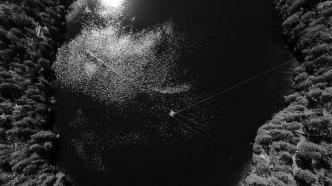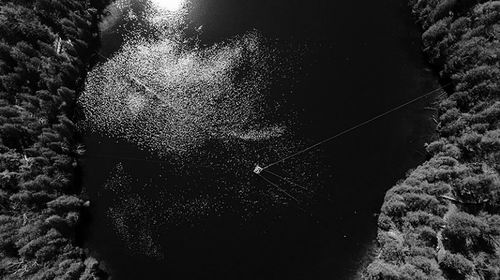

Lake Crawford, Canada, has been nominated as the official site for the Anthropocene Golden Spike. Image credit: Brock University, Canada
On July 11, the Anthropocene Working Group nominated at a Stratigraphy Conference in Lille, France, and a press conference in Berlin, Germany: The official marker for the beginning of the Anthropocene is Crawford Lake in Canada. If the proposal is approved, Crawford Lake's sediment cores will be the global chronostratigraphic unit boundary stratotype profiles and points (GSSPs) marking the beginning of the Anthropocene, commonly known as "golden spikes."
The Anthropocene is the geological era in which humans have profoundly impacted the planet, and researchers have spent 14 years debating when and how humans began changing the planet. Year after year, particles settle into the lake and drift to the bottom, forming layers of sediment that record environmental conditions. Among the pollutants embedded in it are fly ash particles from burning fossil fuels and traces of radioactive plutonium from nuclear bomb tests in the atmosphere. The researchers captured traces of fallout from nuclear bombs and other forms of environmental degradation in the lake's sediment.
Not all geoscientists agree with the Anthropocene golden nail idea. They argue that tying the beginning of this era to a recent time and place ignores the idea that humans have been altering the planet over a much longer period of time.
"European scientists seem to be fascinated that this period started very recently," says Zoe Todd, an anthropologist at Simon Fraser University in Canada. That said, everything that led to this global shift actually started much earlier.
But supporters say formalizing a new era has powerful symbolism. Colin Waters, chair of the Anthropocene Working Group and a geologist at the University of Leicester in the United Kingdom, said that the Anthropocene golden nail is not to acknowledge the beginning of human activities on Earth, but to mark the Earth's response to great changes.
In 2019, the Anthropocene Working Group began discussing a shortlist of Golden Spike sites, from peat bogs in Poland to coral reefs in Mexico. Earlier this year, the group narrowed the shortlist to two lakes: Sihailongwan Lake and Crawford Lake in China's Jilin Province. Both lakes have annual deposits that record changes in the environment over time. In April, Lake Crawford received 60 percent of the working group's yes vote, earning him the title of Candidate Golden Spike.
Although Crawford Lake has a surface area of only 2.4 hectares, it is 24 meters deep, preventing the bottom water from mixing with the upper layer. The lake was formed when a limestone cave collapsed and water flooded the cave. Each summer, as the lake warms, calcium carbonate precipitates out and sinks to the bottom, creating a distinctive white layer that acts as a visual marker of the passing years.
These formations document rising levels of radioactive plutonium fallout from nuclear bomb tests. Cores collected at Crawford Lake in 2019 and 2022 showed that traces of plutonium increased in the early 1950s, but the team led by Francine McCarthy, a micropalaeontologist at Brock University in Canada and leader of the Anthropocene Working Group, this year Additional cores were collected. They found that the year of the golden spike could be 1950, when some environmental changes accelerated, or 1952, when plutonium levels rose sharply.
Over the next few months, the working group will submit proposals for 3 ideas to the Quaternary Stratigraphy Subcommittee. First, Crawford Lake should serve as the golden spike for the beginning of the Anthropocene, the exact year has yet to be determined. Second, the Anthropocene should be a geological epoch ending the Holocene, the first epoch probably being named the Crawford Era. Third, some candidate sites that have not won the title of golden nails of the Anthropocene can be used as supplements to help determine the Anthropocene in different geological settings.
If the proposal passes the next round of voting, it will be submitted to the International Commission on Stratigraphy and finally to the International Union of Geological Sciences. Any part of the proposal may fail in any round. (Original title "China's Four Seas Longwan Lake Lost Selection
Crawford Lake, Canada nominated for The Anthropocene Golden Spike)